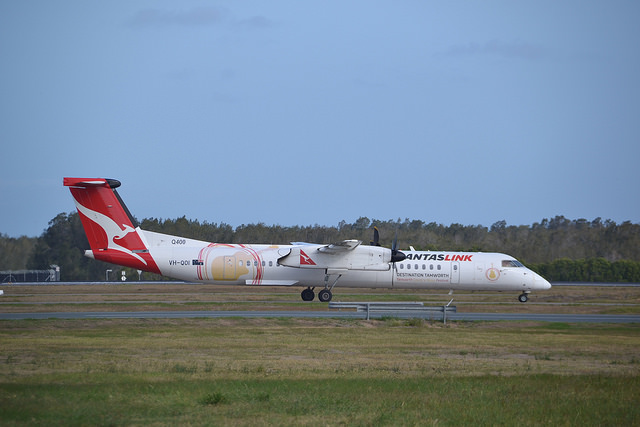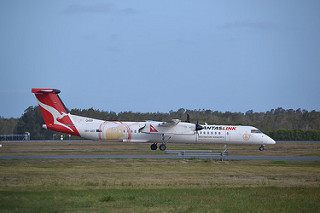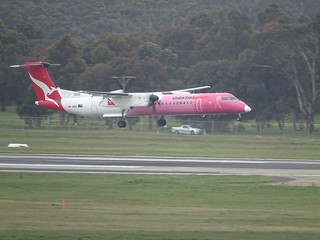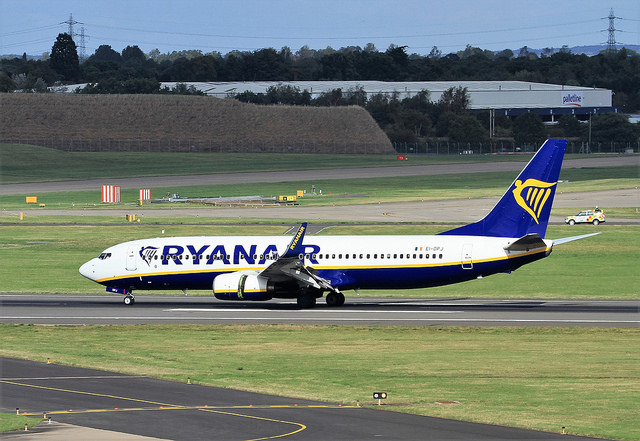Sunstate DH8D near Brisbane on Jun 26th 2018, uncommanded engine shut down in flight due to confusing maintenance procedures, prop did not feather
Last Update: September 16, 2020 / 08:46:13 GMT/Zulu time
Incident Facts
Date of incident
Jun 26, 2018
Classification
Report
Airline
Sunstate Airlines
Flight number
QF-2517
Departure
MacKay, Australia
Destination
Brisbane, Australia
Aircraft Registration
VH-LQD
Aircraft Type
De Havilland Dash 8 (400)
ICAO Type Designator
DH8D
The ATSB annotated: "The flying pilot observed that the only handling difference from an engine failure practiced in the simulator was that when the operating engine was selected to flight idle during the landing, the aircraft yawed significantly more than expected. He commented that it required almost full right rudder to maintain the aircraft on the centreline."
The ATSB released their final report concluding the probable causes of the incident were:
Contributing factors
- During cruise, a bearing in the intercompressor case fractured, leading to an automated in-flight engine shutdown.
- Following detection of category 3 debris on the chip detector and the oil filter, the maintenance personnel discussed a previous detection of debris but incorrectly concluded that it did not need to be considered. This resulted in the aircraft being released to service, and the uncommanded engine shutdown, within the 20 flight-hour limitation.
- The procedures in the aircraft maintenance manual relating to chip detector debris analysis were written in a way that could cause confusion and error. This probably influenced the actions of the maintenance personnel to release the aircraft to service with a deteriorating bearing. [Safety issue] (editorial note: emphasis added by the ATSB)
Other safety factors
- Multiple maintenance personnel did not record 'Fault code 938 - turbomachinery chip detector' as required when conducting 50 hourly inspections.
- There were no processes within the aircraft maintenance organisation or QantasLink to ensure that maintenance tasks associated with fault codes were correctly documented.
Other findings
- After the uncommanded engine shutdown, the propeller did not feather. Instead, it moved to a safe coarse position, which resulted in a decrease in the aircraft’s one engine inoperative performance of 0.5-0.9 per cent compared to a feathered propeller.
The engine mnaufacturer "identified that the uncommanded engine shutdown was the result of a No. 30 bearing fracture. Due to the extent of damage, it was not possible to establish the bearing fracture mechanism. The No. 30 bearing is part of the tower shaft for the accessory gearbox that runs the main engine oil pump and fuel metering unit, among other systems."
The ATSB reported the propeller was examined:
The propeller pitch control unit, propeller overspeed governor, and auxiliary feather pump were sent to the relevant manufacturer for inspection. The auxiliary feather pump was not test run prior to being disassembled and inspected however, nothing was found during the inspections that contributed to the propeller not feathering.
The operator advised that while the propeller did not feather, and the reason for this could not be identified, the propeller did go to a safe coarse condition due to the counterweights in the propeller system, as it would if there was no oil in the propeller system. The manufacturer’s analysis showed that with one engine inoperative, the difference between a counter-weight coarsened propeller and a fully feathered propeller was a 0.5–0.9 per cent decrease in aircraft performance.
The ATSB described the maintenance actions prior to the engine shut down:
On the 13, 18 April, and 27 May, personnel within the CAMO received automated emails from the contracted organisation notifying them of ‘Fault code 938 – Turbomachinery chip detector’ generated by the FAST system, for the right engine on LQD. No actions were taken in response to these emails, and as the procedures were not yet in place, no action was required.
On the 13 April, earlier on the day the CAMO received the first email relating to the fault, personnel working within the AMO signed a work order as complete, recorded that there were no defects and ticked the ‘Fault code(s)’ ‘No’ box on the task card. The fault, recorded in the email received by the CAMO, was most likely generated after this check was completed. This fault was probably cleared on the 18 April, when a separate powerplant message was cleared, and the fault generated again on a flight later the same day resulting in the second email being forwarded to the CAMO. An inspection on 20 April was also completed with no faults recorded and the ‘Fault code(s)’ ‘No’ box ticked.
During an inspection on 26 April, ‘Fault code 938 – Turbomachinery chip detector’ was detected on the CDS. On further inspection, ‘minor fuzz’ was detected on the turbomachinery chip detector.
The AMO categorised the debris as ‘permitted’, which was described in the aircraft maintenance manual as a ‘small quantity of hair like filaments (fuzz) or powder provided there has been no prior history of debris (allowable or non-allowable) within the last 400 hours’.
After consulting the aircraft maintenance manual, the engine was returned to service. The debris was not analysed, and there was no requirement to do so. The fault was recorded in the technical log, and the fault code ‘No’ box was ticked on the task card and work order (Figure 2).
The AMO conducted nine more inspections of the CDS with no defects recorded and the fault code ‘No’ box ticked on each occasion. Different personnel within the AMO completed these inspections.
After the incident, the operator interrogated the CDS to investigate why the FAST system had recorded 938 fault codes, but no such fault codes were recorded during most of the 50 hourly routine tasks. The interrogation found that during the maintenance task on the 30 May, the ‘Fault code 938 – Turbomachinery chip detector’ had been cleared in the CDS. This indicated that when the maintainer interrogated the CDS, they identified fault code 938, and had cleared it.
The AMO could not provide evidence that further actions had been taken in relation to CDS ‘Fault code 938 – Turbomachinery chip detector’ although they stated that it was highly likely that the appropriate maintenance actions had taken place when the faults were cleared.
This omission in the recording of maintenance had not been detected by the AMO, as there was no requirement to ensure that the work completed was recorded in the paperwork correctly. It was also not detected within the CAMO, as personnel working within the technical records area have no way of knowing what unscheduled maintenance was completed unless it was written on a task card.
A review of tasks cards found a number on which the maintainer had listed the fault codes that had been detected and the work completed to clear those codes, but the fault code ’No’ box was ticked (see Figure 2). This was not detected during the assessment of the paperwork by the technical records area, as there was no requirement to check this specific area of the form. The AMO could not explain why the same error was made by different maintainers over a number of inspections.
...
Overnight on 25 June, the FAST system recorded three fault codes - ‘Fault code 938 – Turbomachinery chip detector’, ‘Fault code 915 - Main Oil Filter’ and ‘Fault Code 932 - Scavenge Oil Filter’. Due to the system’s set-up, personnel from the CAMO received an automated email from the contracted organisation notifying them of ‘Fault code 938 – Turbomachinery chip detector’. On receipt of this email, they raised an urgent technical service request (UTSR) which was sent to the AMO.
During scheduled maintenance on the evening of 25 June, personnel from the AMO also noted that the CDS had recorded ‘Fault code 938 – Turbomachinery chip detector’, ‘Fault code 915 - Main Oil Filter’ and ‘Fault Code 932 - Scavenge Oil Filter’. As a result, they conducted an inspection of the engine.
Personnel from the AMO found debris on the turbomachinery chip detector and the main oil filter and classified this as ‘Non-Permitted Category 3’ debris (dark irregular magnetic chips or small clusters of magnetic flakes or all other debris not defined elsewhere, Figure 3). This required that a sample of the debris be sent to a laboratory for analysis.
They then, in consultation with personnel from the CAMO, used a flow chart to determine whether to return the engine to service. This flow chart indicated that if the turbomachinery had a history of contamination within the previous 400 hours, they must ‘wait for the results of the previous lab report prior to continuing operation’. The personnel from the AMO and CAMO together decided not to include the previous permitted ‘minor fuzz’ found on the chip detector on the 26 April, which was within the previous 400 flight-hours, due to an assessment that it did not constitute an occurrence of debris. There was no record in the maintenance information system that ‘Fault Code 938 – Turbomachinery chip detector’ had been received and cleared on previous occasions, as this had not been recorded on the task cards.
The ATSB analysed:
During cruise flight, a bearing fracture within the intercompressor case resulted in an automated shutdown of the right engine. Due to the extent of the damage, and consistent with previous similar occurrences, it was not possible to establish the bearing fracture mechanism.
After the uncommanded engine shutdown, the propeller did not feather as expected, instead going into a design coarse position. This decreased the aircraft’s one engine inoperative performance by up to 0.9 per cent from that expected had the propeller feathered. Detailed technical inspection was unable to identify the reason why the propeller did not feather.
This analysis will discuss the indications of the deterioration of the bearing and the maintenance actions in the months and days preceding the uncommanded engine shutdown. It also examines the maintenance procedure used to determine whether the aircraft should be grounded pending the analysis of the debris found on the turbomachinery chip detector.
Maintenance action
During a number of regular inspections leading up to the detection of what maintenance personnel considered to be category 3 chip detector debris, different maintainers from the operator’s approved maintenance organisation (AMO) had identified ‘Fault Code 938 – Turbomachinery Chip Detector’. For reasons that could not be determined, and contrary to the required procedure, these faults were cleared without recording the fault and maintenance actions in the task card. The associated fault code ‘No’ box was also ticked on each occasion.
There was no process, nor was there a requirement within the AMO, to ensure that the completed maintenance related to fault codes were correctly recorded in the maintenance documentation.
Additionally, there was no way or means for personnel within the continuing air maintenance organisation (CAMO) to detect when unscheduled maintenance was completed but not documented. They also did not have a procedure to ensure that when there were faults recorded on the task card, that the fault code ‘Yes’ box was ticked.
As a result, the opportunity to identify the developing debris trend associated with the gearbox bearing deterioration was missed.
On the evening of 25 June, ‘Fault Code 938 – Turbomachinery Chip Detector’ fault was detected and debris found on the turbomachinery chip detector and the main oil filter. The debris was classified as ‘Non-permitted Category 3’ debris. In consultation, personnel from the CAMO and the AMO decided that the previous instance of debris (26 April) did not constitute a history of debris.
Based on that assessment, they used the information provided in the aircraft maintenance manual to release the engine to service with a 20 flight-hour limitation while a sample of the debris was sent for analysis.
The engine manufacturer’s intent was that the prior ‘fuzz’ should have been considered a history of debris. This would have required the debris detected on the 25 June to be analysed and the results reviewed, before the aircraft was released to service. Had that occurred, the uncommanded engine shutdown would probably have been avoided.
Procedural confusion The aircraft maintenance manual procedures for assessing chip detector debris were written in a way that could cause confusion and error. For example, in describing the classification of the debris, the ‘Non-permitted Category 3’ description did not mention a previous history of debris.
This allowed the user to read the classification description in isolation and, as in this case, disregard the previous instance of ‘permitted’ debris. This was not the manufacturer’s intended interpretation.
Additionally, some of the required maintenance steps relied on the results of debris analysis but it was not always clear what debris was being referred to—current or previous. Terminology was also interchanged without explanation.
These aspects of the assessment flowchart most likely influenced the maintenance personnel’s decision to discount the previous history and release the engine to service with a 20 flight-hour limitation, while they waited for the results of the debris detected on the 25 June to be analysed.
Aircraft Registration Data
Incident Facts
Date of incident
Jun 26, 2018
Classification
Report
Airline
Sunstate Airlines
Flight number
QF-2517
Departure
MacKay, Australia
Destination
Brisbane, Australia
Aircraft Registration
VH-LQD
Aircraft Type
De Havilland Dash 8 (400)
ICAO Type Designator
DH8D
This article is published under license from Avherald.com. © of text by Avherald.com.
Article source
You can read 2 more free articles without a subscription.
Subscribe now and continue reading without any limits!
Read unlimited articles and receive our daily update briefing. Gain better insights into what is happening in commercial aviation safety.
Send tip
Support AeroInside by sending a small tip amount.
Related articles
Sunstate DH8D at Mildura on Jul 22nd 2025, flaps problem on departure
A Sunstate Airlines de Havilland Dash 8-400 on behalf of Qantas, registration VH-QOJ performing flight QF-2079 from Mildura,VI to Melbourne,VI…
Sunstate DH8D at Horn Island on Jun 26th 2024, wrong flap setting for departure
A Sunstate Airlines de Havilland Dash 8-400 on behalf of Qantas, registration VH-QOI performing flight QF-2489 from Horn Island,QL to Cairns,QL…
Sunstate DH8D at Broken Hill on Dec 26th 2024, hard landing
A Sunstate Airlines de Havilland Dash 8-400, registration VH-QOD performing flight QF-2017 from Sydney,NS to Broken Hill,NS (Australia), landed on…
Sunstate DH8D at Broken Hill on Dec 23rd 2024, gear problem
A Sunstate Airlines de Havilland Dash 8-400 on behalf of Qantas, registration VH-QOI performing flight QF-2017 from Sydney,NS to Broken Hill,NS…
Sunstate DH8D at Sydney on Dec 1st 2023, hydraulic leak
A Sunstate de Havilland Dash 8-400 on behalf of Qantas, registration VH-QOH performing flight QF-2008 from Sydney,NS to Tamworth,NS (Australia), was…
Newest articles
Buffalo B732 at Goose Lake and Yellowknife on Oct 20th 2025, uncommanded nose gear extension and collapse
A Buffalo Airways Boeing 737-200, registration C-GTVO performing flight J0-202 from Goose Lake,NU to Yellowknife,NT (Canada) with 3 crew on board,…
Ryanair B738 at Cluj on Nov 3rd 2025, first officer incapacitated
A Ryanair Boeing 737-800, registration EI-DPJ performing flight FR-2682 from Milan Bergamo (Italy) to Cluj (Romania), was descending towards Cluj…
Subscribe today
Are you researching aviation incidents? Get access to AeroInside Insights, unlimited read access and receive the daily newsletter.
Pick your plan and subscribePartner

ELITE Simulation Solutions is a leading global provider of Flight Simulation Training Devices, IFR training software as well as flight controls and related services. Find out more.
SafetyScan Pro provides streamlined access to thousands of aviation accident reports. Tailored for your safety management efforts. Book your demo today
AeroInside Blog
Popular aircraft
Airbus A320Boeing 737-800
Boeing 737-800 MAX
Popular airlines
American AirlinesUnited
Delta
Air Canada
Lufthansa
British Airways






